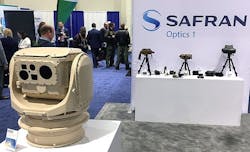Navy chooses electro-optical surveillance sensors from Safran Optics 1 for Marine Corps perimeter security
CRANE, Ind. – U.S. Navy surveillance researchers needed an electro-optical and infrared sensor for U.S. Marine corps perimeter security. They found their solution from Safran Optics 1 Inc. in Bedford, N.H.
Officials of the Naval Surface Warfare Center Crane Division in Crane, Ind., announced a potential $12 million five-year contract to Optics 1 on Wednesday to build, repair, and support Ground-Based Operational Surveillance System (G-BOSS) Light Optical Camera (GBLOC).
Optics 1 engineers will build a tripod mounted electro-optical and infrared sensor that provides daylight and night-vision imagery for detecting, classifying, and identifying targets as part of the Marine Corps G-BOSS sensor suite.
G-BOSS is a self-erecting, trailer-mounted tower that provides a stable, elevated platform for sensors and communications to provide beyond-the-fence surveillance for Marine Corps installations. The system typically is deployed in the Middle East and other locations for perimeter security.
Related: Technology for border and perimeter security
Each G-BOSS tower can operate independently and has a 107-foot or 80-foot tower; a multi-spectral electro-optic/infrared sensor suite composed of a FLIR Systems Star SAFIRE IIIFP camera with a laser pointer and range finder; a ThermoVision 3000 camera with a global Positioning System (GPS); a man-portable surveillance and target acquisition radar (MSTAR); and a Ground Control Station (GCS) with optional Remote Ground Station (RGS).
G-BOSS can integrate signals from unmanned aerial vehicles (UAVs) using the VideoScout video management system and from the tactical remote sensor suite unattended ground sensors. G-BOSS typically is deployed at Marine Corps forward operating bases, command outposts, battle positions, and entry control points.
Safran Optics 1 specializes in laser rangefinders, markers, visual augmentation systems, precision north finding and inertial navigation systems, targeting solutions, and custom systems.
Optics 1 produces the PASEO advanced panoramic sight for armored personnel carriers and main battle tanks. It is for fire-on-the-move capabilities for vehicle gunner and commander stations, and can perform forward artillery observation.
The company also produces the Airborne Reconnaissance Targeting Integrated System (ARTIS) 410 multispectral ultra-long-range observation and precision-targeting system with high-definition sensors and advanced embedded computing. It works at standoff distances during the day and night, and is designed to identify targets quickly in four spectral wavebands: color CMOS, near-infrared (NIR), short-wave infrared (SWIR), and mid-wave infrared (MWIR).
On this indefinite-delivery/indefinite-quantity contract, Optics 1 will do the work in Bedford, N.H., and should be finished by March 2024.
For more information contact Safran Optics 1 online at www.optics1.com, or the Naval Surface Warfare Center-Crane at www.navsea.navy.mil/Home/Warfare-Centers/NSWC-Crane.
Ready to make a purchase? Search the Military & Aerospace Electronics Buyer's Guide for companies, new products, press releases, and videos

